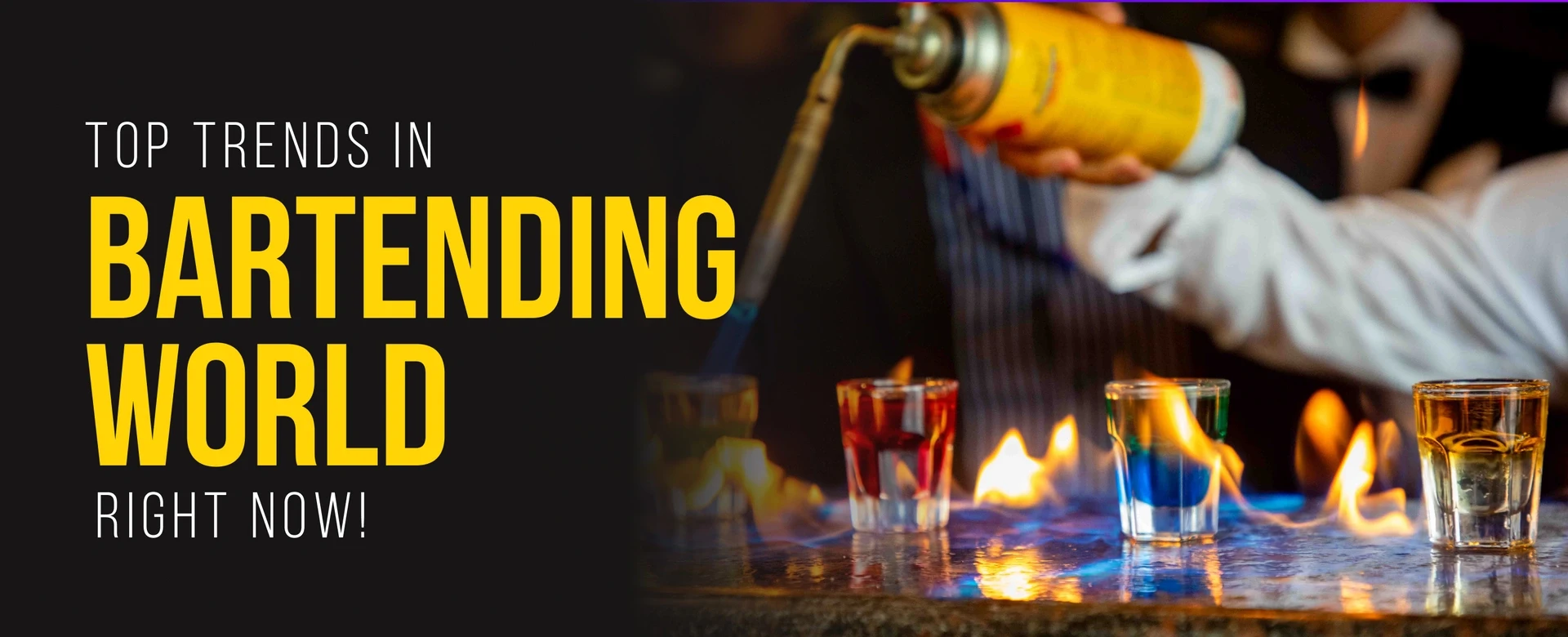In the ever-evolving world of mixology, hotel bartenders are constantly pushing the boundaries of creativity to offer guests an unforgettable experience. From innovative concoctions to unique presentation styles, the bartending scene in hotels has witnessed a surge in trends that are redefining the art of cocktail-making. In this blog, we’ll delve into the latest trends that are shaking up the hotel bartending landscape and explore some of the most enticing cocktails that have taken the spotlight. But before we explore the latest trends, let’s take a step back and consider the foundational aspects of bartending.
Bartending Course in India: Before one can embark on a career in bartending, it’s essential to acquire the necessary skills and knowledge. In India, aspiring bartenders have the opportunity to enroll in bartending courses that provide comprehensive training in mixology, customer service, and bar management. These courses equip students with the expertise needed to excel in the hospitality industry.
Career in Bartending: Bartending isn’t just a job—it’s a rewarding career path filled with opportunities for growth and creativity. With the right training and experience, bartenders can work in upscale hotels, trendy bars, or even start their own ventures. A career in bartending offers the chance to connect with people from all walks of life while showcasing a passion for crafting exceptional drinks.
Bartending Course Fees: While pursuing a bartending course in India, aspiring bartenders may wonder about the associated costs. The fees for bartending courses vary depending on factors such as the institution, duration, and level of training. However, investing in quality education can yield invaluable returns in terms of skill development and career advancement.
Now, let’s delve into the latest trends that are shaping the world of hotel bartending.
Bartending Trends in 2024: From classic cocktail craftsmanship to cutting-edge techniques, mastering bartending skills in 2024 requires a diverse set of talents. Let’s explore some of the essential skills and trends that define the craft of bartending in the present day.
New Trends in Bartending: Sustainability has emerged as a key trend in bartending, with bartenders incorporating locally sourced, organic ingredients and adopting minimal waste practices. From eco-friendly straws to compostable garnishes, hotels are embracing sustainability while delivering exceptional taste in every sip.
New Trends in Mixology: Interactive and experiential cocktails are gaining popularity, allowing guests to participate in the drink-making process. DIY cocktail stations, molecular mixology techniques, and cocktail theater add an element of excitement and engagement to the drinking experience.
How to Become a Bartender: For those aspiring to become bartenders, the journey begins with a passion for mixology and a commitment to learning. Pursuing a bartending course in India can provide the necessary skills and knowledge to excel in this field. Additionally, gaining hands-on experience through internships or entry-level positions is essential for building a successful bartending career.
Bartending Interview Questions: When preparing for a bartending job interview, it’s important to be familiar with common questions that may arise. Interviewers may inquire about your experience, knowledge of cocktails, customer service skills, and ability to handle high-pressure situations. Being prepared to answer these questions confidently can make a positive impression during the interview process.
As the world of bartending continues to evolve, it’s essential for aspiring bartenders to stay informed about the latest trends and developments. By investing in education, honing their skills, and embracing opportunities for growth, bartenders can embark on rewarding careers in this dynamic industry. Cheers to the exciting journey ahead in the world of hotel bartending!
Who is a bartender?

A bartender is a hospitality industry professional who mixes and serves alcoholic beverages in a bar in restaurants serving wine. Besides beer and wine, a bartender also mixes cocktails like Mojito. Bartenders have the authority to refuse drinks to customers who have not attained the legal drinking age requirements. Bartending is considered both a profession and an art.
History of bartending
Bartending – the art and profession of serving wine and making cocktails and mocktails has a history that dates back to Greek and Rome. In early history the first bartenders are believed to have existred in ancient Greek and Rome when wine revelers relied on expert craftsmen to pour their favorite drinks.
During trhe 15th century in Europe bartenders were mainly innkeepers, who made their own spirits and ales. In America, the bartending culture remained vibrant in early 20th century even when prohibition laws were enforced by the federal government.
Bartending During the Prohibition Era
After the rise of the cocktail in the early 20th century, Americans were faced with prohibition laws from the Federal government. Popular cocktails like the tonic and gin were believed to have been invented during the prohibition age.
Bartending in Modern Times
Following the repeal of the prohibition laws, bartending became a fad in the United States. This was the period when the first bartending training schools were opened which taught different bartending courses to students. As the economy boomed, lifestyles became more luxurious and easy going and wine-drinking became rampant. The flourishing of ethe cocktail andmocktail cultire boosted the career of bartenders.
Bartending Trends in 2024
From classic cocktail craftsmanship to cutting-edge techniques, mastering bartending skills in 2024 requires a diverse set of talents. Let’s delve into the essential skills and trends that define the craft of bartending in the present day.
Sustainable Mixology
Sustainability is no longer just a buzzword; it has become a guiding principle in many hotel bars. Bartenders are incorporating locally sourced, organic ingredients and reducing waste by reusing and repurposing elements. From eco-friendly straws to biodegradable garnishes, hotels are embracing the green movement while still delivering exceptional taste in every sip.
a. Local and Organic Ingredients:
Hotel bartenders are increasingly sourcing their ingredients locally and prioritizing organic options. This not only supports nearby communities but also ensures the freshest and most flavorful components for cocktails.
b. Minimal Waste Practices:
To reduce environmental impact, bars are adapting practices to minimize waste. This includes using every part of an ingredient, repurposing leftovers for syrups or garnishes, and incorporating compostable or reusable items in place of single-use plastics.
c. Eco-Friendly Presentation:
Sustainability extends to the way cocktails are presented. Bartenders are opting for eco-friendly straws, recycled glassware, and even edible garnishes to minimize the ecological footprint of each drink.
Interactive and Experiential Cocktails-
Hotels are turning cocktail crafting into an interactive and engaging experience for guests. Some establishments offer DIY cocktail stations where patrons can mix their own drinks under the guidance of skilled bartenders. Smoke-infused glasses, edible garnishes, and molecular mixology techniques add a theatrical flair, turning a simple drink into a multisensory experience.
a. DIY Cocktail Stations:
Hotels are enhancing guest engagement by introducing DIY cocktail stations. Patrons can select their base spirits, mixers, and garnishes under the guidance of skilled bartenders, fostering a sense of creativity and personalization.
b. Molecular Mixology:
Incorporating scientific techniques such as molecular gastronomy, bartenders are creating visually stunning and texturally intriguing cocktails. Smoke-filled glass domes, edible bubbles, and molecular spheres add an element of surprise and entertainment.
c. Cocktail Theater:
Theatrics in cocktail-making involve creative presentation styles, such as cocktails served in smoking vessels, drinks set ablaze, or interactive elements like tableside mixing. These visually appealing techniques elevate the overall drinking experience.
Low-ABV and Health-Conscious Cocktails-
With an increasing focus on wellness, hotel bartenders are creating low-alcohol or alcohol-free options that don’t compromise on flavour. These lighter alternatives cater to health-conscious guests while providing a diverse range of choices. Infusions with herbal and wellness-focused ingredients are gaining popularity, ensuring that patrons can savour their favourite drinks without guilt.
a. Wellness Infusions:
Hotels are infusing their cocktails with wellness-promoting ingredients like turmeric, ginger, and adaptogens. These additions not only contribute to the flavor profile but also align with the growing demand for drinks that offer health benefits.
b. Low-Alcohol Alternatives:
Acknowledging the trend towards moderation, bartenders are crafting lower-alcohol or alcohol-free options. These beverages, often referred to as “mocktails,” maintain complexity and taste without the higher alcohol content.
c. Functional Ingredients:
Incorporating functional ingredients like kombucha, matcha, and herbal infusions, bartenders are creating drinks that not only taste good but also contribute to a sense of well-being.
Global Influences and Fusion Cocktails-
Cultural diversity is making its mark on hotel bar menus, with bartenders drawing inspiration from global flavours and traditional ingredients. Fusion cocktails that blend elements from different cuisines and regions create a unique and adventurous drinking experience. From Asian-inspired infusions to Latin American spice blends, hotels are embracing the world in a glass.
a. Cultural Fusion:
Bartenders are exploring a diverse range of international flavors, blending ingredients from different cultures to create fusion cocktails. This might involve incorporating spices from India, herbs from the Mediterranean, or unique fruits from South America.
b. Ethnic Garnishes:
Garnishes play a crucial role in adding a cultural twist to cocktails. Bartenders are experimenting with unique and authentic garnishes that complement the flavor profile of the drink and provide a visual representation of its cultural inspiration.
c. Regional Collaboration:
Hotels are partnering with local producers and artisans to source authentic ingredients, creating a collaborative approach that celebrates both the hotel’s identity and the richness of the surrounding community.
Artisanal and Craft Spirits:
The rise of craft spirits continues to influence hotel bartending, with a growing emphasis on small-batch and artisanal distilleries. Guests are treated to unique and high-quality spirits, often locally produced, enhancing the authenticity of the drinking experience. Handcrafted bitters, syrups, and infusions further contribute to the bespoke nature of these cocktails.
a. Locally Sourced Spirits:
Bartenders are curating a selection of craft spirits from local distilleries, offering guests a taste of the region’s unique and small-batch creations.
b. House-Made Infusions:
Crafting house-made infusions, bitters, and syrups is becoming a standard practice, allowing bartenders to showcase their creativity and provide patrons with exclusive and bespoke flavour profiles.
c. Limited-Edition Releases:
Hotels are introducing limited-edition cocktails featuring rare and small-batch spirits, creating a sense of exclusivity and encouraging guests to explore new and unique flavour combinations.
Tech-Infused Mixology-
In the digital age, technology is finding its way behind the bar. Smart ice makers, precision pourers, and even augmented reality cocktail menus are becoming part of the bartender’s toolkit. These innovations not only streamline the mixing process but also add a futuristic touch to the overall guest experience.
a. Smart Bar Tools:
Incorporating technology into the bartending process, smart ice makers, precision pourers, and automated mixing systems enhance efficiency and precision, ensuring consistency in every pour.
b. Augmented Reality Menus:
Some hotels are embracing technology by offering augmented-reality cocktail menus. Guests can use their smartphones or tablets to explore 3D representations of cocktails, providing a visually engaging and interactive ordering experience.
c. Digital Mixology Classes:
To cater to the growing interest in mixology, hotels are offering digital mixology classes where guests can learn the art of crafting cocktails from the comfort of their rooms through online tutorials and interactive sessions.
Classic Cocktails and their origin
As we navigate the dynamic landscape of hotel bartending, it’s clear that creativity knows no bounds. The latest trends in cocktails reflect a commitment to sustainability, a celebration of diverse global flavours, and a dedication to providing guests with memorable experiences.
Whether you’re a seasoned cocktail enthusiast or a curious newcomer, the hotel bar scene is ripe with innovation, inviting you to embark on a flavorful journey that goes beyond the traditional. Cheers to the exciting world of hotel bartending and the delightful concoctions that await!

Cocktails have a rich and varied history. Here is a list of the world’s famous cocktails and their origin.
1. Margarita
The classic Margarita is one of the most ordered and most popular cocktails in America for the world. The traditional Margarita recipe includes tequila, Triple Sec and lime juice. Sometimes a salt rim is also served for the perfect balance of sweet, sour and salty.
2. Cosmopolitan
The Cosmopolitan is a deliciously sweet cocktail which is also considered one of the world’s most popular cocktails! Blending vodka, Cointreau and cranberry juice and traditionally served in a martini glass, the Cosmo is the cocktail of choice for many glamorous individuals.
3. Daiquiri
The Daiquiri is actually the most-ordered rum cocktail in pubs and bars across the globe. It is perfectly suited during a tropical holiday in hot weather with a blue sky on top.
This classic, popular cocktail, which remains a Cuban speciality, combines just 3 very simple ingredients, rum, citrus juice and sugar for the fresh flavour we all enjoy. Typically garnished with a lime slice too, the Daiquiri is one of the most well-balanced cocktails around.
4. Gimlet
The Gimlet combines gin and lime to create a simple, ultra-refreshing drink that has stood the test of time to become one of the most popular cocktails around. With its sharp kick, the Gimlet has an unmistakable flavour to suit warm summer evenings.
It is believed that this classic cocktail was first mixed in the late 18th century by Surgeon Admiral Sir Thomas Gimlette of the Royal Navy who added lime cordial to his sailors’ daily dose of gin to keep scurvy at bay. While it may not have the most glamourous of backgrounds, the Gimlet has long been adopted as one of the most sophisticated drinks to order.
5. Manhattan
The Manhattan cocktail is one of the most famous cocktails in the world which has survived countless trends and survived prohibition. It deserves its spot amongst the world’s most popular cocktails! Made with whiskey, sweet vermouth and bitters the Manhattan is the perfect after-dinner tipple.
First mixed in 1870 at the Manhattan Club by Jennie Jerome, the mother of Winston Churchill, the cocktail was a huge hit and has remained just as popular ever since. It’s now widely available in bars, cafes and restaurants all over the world and is very highly regarded by both bartenders and patrons alike.
6. Negroni
The Negroni is punchy, bittersweet and the ideal dinnertime . It is a classic Italian cocktail and can be consumed any time of the day, Combining equal parts of gin, vermouth and Campari, the Negroni will always remain popular! Poured over ice and with a slice of orange to garnish, it’s easy to see why it’s one of the most popular cocktails not only in Italy, but around the world.
7. Old Fashioned
The Old Fashioned cocktail is 200 years old and remains popular. It is made by mixing Bourbon Whiskey, bitters, sugar and water.
It was probably first made in the late 1800s. This was when new liquors became available to bartenders, resulting in new and improved whiskey cocktails. But, many bar-goers simply ordered a cocktail ‘the old fashioned way’. Even today the Old Fashioned has been the number one selling cocktail in many bars. You just can’t beat a classic!
8. Espresso Martini
The Espresso Martini is the caffeinate, cocktail which is the ideal choice for coffee lovers. Combining vodka and coffee liquor, it has a rich, robust and special flavour and has a mythical nature to it.
The Espresso Martini was created by a bartender named Dick Bradsell who was well-known for reviving the cocktail scene in London. At either Fred’s Club or the Soho Brasserie (depending on who you ask) in the 1980s, a model asked Bradsell to make her a drink that would wake her up and give her a good time. Bradsell mixed vodka with espresso from the bar’s coffee machine and named it the Vodka Espresso. Since then, the cocktail has undergone many name changes, but the ionic combination has remained the same.
9. Passionfruit Martini
Named as the UK’s favourite drink, the Passion Fruit Martini has become the go-to tipple for many. This modern-classic popular cocktail is made with vanilla vodka, fresh passion fruit, passion fruit liqueur and lime juice. It’s also served with a shot of champagne or prosecco on the side to pour over the passion fruit to release all the wonderful flavours.
Created in London by the owner of the LAB bar, the Passion Fruit Martini was an instant hit and became the ultimate party drink. Stylish, fun and indulgent, this cocktail evokes confidence in those who drink it and looks amazing in the classic martini-style glass. We’re certain the Passion Fruit Martini will remain highly popular for decades.
10. Mimosa
Over the last few years, the humble Mimosa has soared in popularity! Traditionally served in a champagne flute at brunch, weddings or in first class on some airlines, the Mimosa combines just two ingredients, champagne and chilled orange juice.
Invented by Frank Meier in 1925, the Mimosa was first served at The Ritz Hotel in Paris. Eventually, it was picked up by the British and was loved so much by the royal family that it took the rest of the world by storm. Nowadays, both American and European brunches are incomplete without a Mimosa. The cocktail is so popular there is even a National Mimosa Day to celebrate it (May 16th if you were wondering).
Want to indulge in a delightfully refreshing Italian cocktail? Read our article on the 3 best Campari cocktails that Italy has to offer.
Looking for the perfect cocktail gift? Whether it’s for your mum, sister, brother, partner or friend, checkout our fantastic selection of cocktails gifts for her and cocktail gifts for him that are sure to delight.
Conclusion
The world of hotel bartending is a dynamic and ever-evolving space where innovation and creativity thrive. These trends not only reflect the current preferences of patrons but also showcase the ingenuity of bartenders as they continually push the boundaries of mixology. Whether you’re a seasoned cocktail enthusiast or a curious newcomer, exploring these trends offers a delightful journey into the diverse and exciting realm of hotel bartending. Cheers to the evolving art of cocktail craft.








